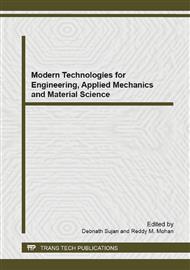p.46
p.52
p.57
p.62
p.69
p.74
p.81
p.86
p.91
The Investigation of Microstructures Fabrication on Quartz Substrate Employing Electron Beam Lithography (EBL) and ICP-RIE Process
Abstract:
The fabrication of micro or nano-structures on quartz substrate has attracted researchers' attention and interests in recent years due to a wide range of potential applications such as NEMS/MEMS, sensors and biomedical engineering. Various types of next generation lithographic methods have been explored since optical lithography physical limitations has hindered the fabrication of high aspects ratio (HAR) structure on quartz substrates. In this research, the top-down fabrication approach was employed to fabricate microstructures on quartz substrate using Electron Beam Lithography (EBL) system, followed by the pattern transfer process using Inductively Coupled Plasma-Reactive Ion Etching (ICP-RIE) technique. The factors that influenced pattern definition include the type of electron beam (e-beam) photoresist, e-beam exposure parameter such as spot size, working distance, write field, step size, e-beam current, dosage as well as the type of developer and its developing time. The optimum conditions were investigated in achieving micro or nano-structures. Field emission scanning electron microscopy (FESEM) with energy-dispersive X-ray (EDX) and atomic force microscope (AFM) were utilized to characterize the structures profiles.
Info:
Periodical:
Pages:
69-73
Citation:
Online since:
June 2014
Authors:
Price:
Сopyright:
© 2014 Trans Tech Publications Ltd. All Rights Reserved
Share:
Citation:


